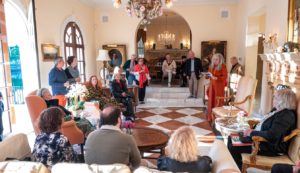|
Getting your Trinity Audio player ready...
|

(Photo Credit: Smash Pixel)
The annual meeting of the Historic Preservation Association of Coral Gables (HPACG) was celebrated recently at the elegant 1927 Venetian-style palazzo home of Ajit and Maria Alicia Asrani.
The residence is part of the Venetian Village or “Venetian Country Type Houses” — one of a number of thematic housing developments planned for the city, but never fully completed due to the 1926 hurricane and subsequent real estate bust.
The home is one of only two identified as part of the “Venetian Village.” It was designed by Phineas Paist. This imposing compound on the edge of the Coral Gables Waterway incorporates the many elaborate details of the Mediterranean Revival style of architecture.
Guests, new and returning members, gathered to welcome the New Year, hear the state of the organization and year-in-review, and ratify the 2022 board slate. The new board consists of Karelia Martinez Carbonell, president; Brett Gillis, vice president; Lisa Bennett; Alice Goldhagen, and David Mitchell. Attending members received a complimentary HPACG tote bag.
Year in review
Martinez Carbonell began her presentation with a quote by a former HPACG board member and past architectural historian for the National Register of Historic Places, who observed, “Without reservation, it is highly apparent that the Historic Preservation Association of Coral Gables has demonstrated superlative achievement in the field of preservation and has espoused the ideal to save America’s historic places. The focus of HPACG, throughout its existence, is indicative of its desire to protect properties that convey special sense of time and place.”
Established in 1991, HPACG marked its 30th anniversary in 2021 and joined the ranks of the 30-something: mature, yet youthful. With a solid past and an eye to the future, the group continues its mission of promoting the importance of historic resources and their preservation.
For its young age, HPACG has achieved outstanding success in historic preservation efforts.
In carrying out its mission, the HPACG has effectively communicated the value of historic preservation to its membership. Through its promotional activities, HPACG has exhibited leadership in issues of importance to historic preservation, and has established itself as one of the leaders in statewide preservation advocacy.
Taking an active part
The Historic Preservation Association of Coral Gables has taken an active role in partnering with the city’s historic preservation efforts. Members of the HPACG have been active in supporting applicants for Special Certificates of Appropriateness, variances from the Zoning Code, and determination of historic designation. Moreover, the HPACG disseminates information of the local tax incentives available to owners of historic properties.
In 2021, HPACG and its members advocated and succeeded for the designation of over 10 distinct properties and submitted an application to review designation for Miracle Mile.
Looking ahead 2022
Preservation is not just about saving old buildings it is now an important component in saving our planet.
HPACG asks the public to please consider the detrimental effects to the environment before any more destruction of the built environment makes way for new construction. Any sustainability initiative must tackle the growing problem.
As for Coral Gables, if the city is serious about attaining carbon neutrality in the near future …it must consider the facts such as that it takes close to 100 years to offset the carbon debt that is incurred when an existing structure is replaced.
Below is an excerpt from the National Trust for Historic Preservation that puts in context how new construction adversely affects our planet.
“Arguments that promote a practice of disposable real estate are unsustainable at best and at worst environmentally catastrophic. [There is…] embodied carbon within existing structures, [and] the fact that it can take up to 80 years to offset the carbon debt that is incurred when an existing structure is replaced, even if the new building is highly energy efficient. New buildings…will likely never offset the carbon cost of their construction. We don’t have time to simply build our way to a sustainable future.”
In 2022 the organization will continue to advocate for preservation of our cultural patrimony and preservation of our planet.





